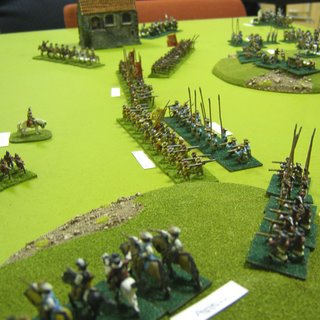The two armies before the battle; The Royalists under Hopton with 6 Horse troops, 6 companies of Foot and 2 cannon:

Parliament, under Waller; 5 Horse and 6 Foot, 3 cannon:

Being Peter Pig rules there is a pre-game sequence to be carried out, some may call it foreplay even (not my opponent though!). The campaign system determines a number of details about the game, such as who is the attacker (he who ends up marching most) supplies, disease and losses in skirmishes. All of which goes a long way to adding character and a back story to a game. For my part as Parliaments true hand, I found disease and cavalry engagements cost me men, but I was left with a more experienced army overall. The net effect for the Royalists were negligable in this instance; he managed to avoid both the good and bad results.
The campaign determined Waller was the attacker, so Hopton had to choose his field of battle, and see which of his troops were available. I'd have to say Hopton picked his field of battle very, competitively, I had no luck influencing it. However when it came to reserves, he found himself with few troops on the ground.
Hopton Deployed an modest foot centre, defending a stonewalled field, with Horse flanks. Waller deployed his weakest troops to the left, a strong Foot and Artillery centre, and a veteran Horse flank on the right:

There was an opening Cannonade by both sides, which saw Wallers heavy gun 'Bess' inflict casualties on the Royalist centre. Once this was over the Parlimentary foot began an enthusiastic advance.

The Royalists elected to stand and take it until the reserves arrived in force, meanwhile the centre of the Parliamentarians closed, whilst the Horse moved more slowly.
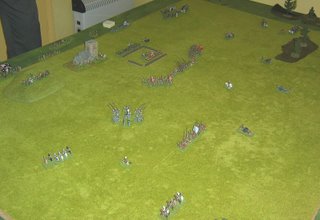
The centre moved into range of the Royalists and started to hammer them with fire, The royalists however were able to keep their heads down and suffered negligable losses. Hopton kept them in check and used the field as a strong point to marshal his forces from as a trickle of reserves began to arrive.
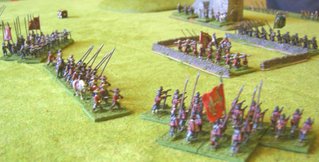
On Wallers right Hoptons horse charged, and did some harm, but the Parliament horse could throw reserves in where the royalsts could not, and soon pursued the remnants of the royalist troop off the field. Then another troop of royalists inflicted a similar result onto another unit of the right flank, they pursued of course, taking their commander with them. Not having a commander around can cripple forces, but even so this left my infantry exposed, so as a precaution Waller formed the right flank company of foot into a pike stand.
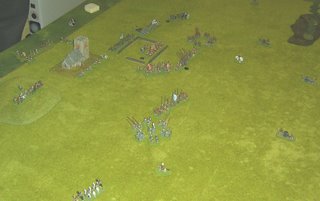
It was time to finish the business of the day. With both Royalist flanks clearly stalled, Waller sent the Tower Hamlets trained band in against the field. Melees involved lots of dice rolls in this fight it was around 40 D6 for me against 30 for the Royalists. Hoever they were conscripts, whereas the trained band were London veterans. I had twice the chance of causing damage, and did so with aplomb.
The Conscripts were wiped out, and Hopton fell amongst them. The Royalists had to hand command to another in the centre (a dice roll determining quality), sadly only toadying fop was available for the task. His brief command was of little help to their campaign; he too was killed when the trained band rolled up the second company of foot in the centre. The next available commander could was barely old enough to sit in a saddle, and despite some reserves coming up into places they could stall the enemy, he decided to seek Parley.
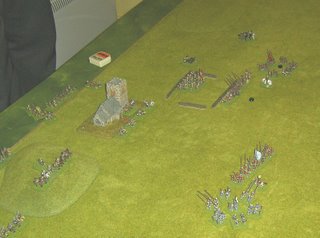
Parley gives a commander opportunity to end a battle early on favourable terms, in this instance Waller was prepared to listen, and the parley went well for the Royalists, but none the less they were found to be well beaten; to everyones relief, Hopton limped into camp late that night, anasty concussion and a cracked skull had left him amogst those lain on the field until sunset.
All in all Regiment of Foote give an excellent feel for the period, with lots of nuances that add to it reflecting the particular circumstances of the English Civil War. It has to be notable too, as a game that possible requires more dice than a game of Warhammer.
It plays to all the Peter Pig/RFCM strengths, is reasonably quick, and good fun.

 I need to relearn my favoured colours these goblins are greener and more cartoony than my normal goblins, but overall I was really impressed. The cover was excellent over a black undercoat, the paints were a revalation for being so smooth and consistent. All I had to do was shake the bottle and get on with it. The paints mixed well and went on smooth; and didn't dry so fast that the brush suffered.
I need to relearn my favoured colours these goblins are greener and more cartoony than my normal goblins, but overall I was really impressed. The cover was excellent over a black undercoat, the paints were a revalation for being so smooth and consistent. All I had to do was shake the bottle and get on with it. The paints mixed well and went on smooth; and didn't dry so fast that the brush suffered. 


